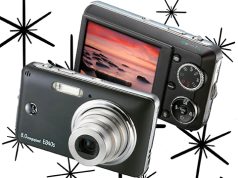
It’s not that bad, of course, but it sure makes things interesting when retailers come down on different sides of a question. I started out with the fact that more photos are being taken with smartphones than any other camera and launched right into it: What are you doing about that? Are you embracing or fighting, or is your move an amalgam of both?
Buckle your seat belt.
Mike Woodland
Dan’s Camera City
Allentown, Pennsylvania
Trying to stop people from using cameraphones and instead use a real camera is like trying to bail the Titanic with a bucket. People are going to choose what they’re going to choose, and it’s up to us to respond and find ways to stay relevant given their choices. The technology is to a point now where you can’t really pooh-pooh the cameraphone, and it’s so pervasive you can’t avoid it. You either embrace it or it runs you over. We’ve taken the embracing approach and updated our iPhone app to be more robust . . . and we are in the process of training our staff to be certified social imaging experts.
Which entails . . .?
Getting them up to speed on any type of mobile device; making sure they’re familiar with connecting to Facebook and Instagram; and really immersing them in the world of that type of technology. Some of them are already there, some aren’t. We’re defining what they need to be proficient at helping customers. We want to make sure our staff knows exactly how to get photos in or out of Facebook with the iPhone app, with our kiosk or from a variety of connecting cameras that are out there now. Things have shifted from [customers’ photos] just sitting on their hard drives or memory cards to customers wanting to move them around to various places.
Something specific you’ve had training success with?
A while back we partially funded the purchase of an iPad or an Android tablet for staff so they would become proficient from their own use of the technology; they’d know how the various apps and connections work, and what are the limitations. Ultimately, we hope to get some great business from it, but either way, at this point our main goal is just to be sure we’re staying relevant, and that means we can’t focus just on the phone part. It’s how people get photos down from Facebook if they want to make prints and how they can do it from our kiosk, through our website, our app. And if they want to put images up there, how they can do it besides going home and copying everything to a computer. There are so many options, so many different means. Some require a particular app to be used, some an existing Wi-Fi network; some generate their own network and connection point.
So that’s the relevancy part. What about profits beyond prints?
We showcase iPhone cases and the many cool things we can produce, which for many people have more appeal than a print. And a couple of times a year we run a one-hour seminar on “Your iOS Device and Image.” We always get a decent amount of people turning out to see what they may not know.
Young people or older?
Primarily middle age and up. We really have to talk up fun, fancy apps if we’re trying to appeal to younger people. We’ve had the most success by going out to groups, clubs and organizations, running free seminars for them and incorporating a lot about cameras and cameraphones and items we can make—groups including young readers’ clubs at libraries, with parents and young kids attending, which is a great demographic. And the library loves a free presentation that keeps people finding value in coming to the library.
Do you sometimes suggest something better than a cameraphone for customers’ special occasions or events?
Our store is full of a lot of examples of what this or that product can do for you, but honestly I’m a little hesitant to try to put down something that is likely serving them well in many other areas. It’s a tough thing to say, “Take a real camera.” As a consumer, that might turn me off a little.
Brian Noble
Noble’s Camera Shops
Hingham, Massachusetts
The problem I’m running into is the customer who comes in and just hands me his cell phone to get the photos off. We have an app that you can download and e-mail your pictures to us from your iPhone, but most people are like, “Huh? How? Here, you do it.” The kiosk applications we’ve got that allow them to transfer their images so they can make prints are inconsistent and unreliable because there are so many cell phones—something like 372 different models, and those are just the current ones.
Do you talk to your customers about other, maybe better ways to take pictures?
We are trying to educate customers that they really don’t want to store images for a long time on their phones, and that right now their phone is not the best vehicle for shooting a picture, but it’s like spitting in the wind. The phone is with them all the time. George Eastman wanted to make the camera as ubiquitous as the fountain pen—and now it is. You can argue about the quality of digital pictures obtained on a cell phone, but the fact is there are more images being taken because people have their phones.
The best camera is the one that’s with you.
Right, but I hate it when people go on a cruise and take only their cell phone. I get that you go to your kid’s school function and don’t think about it and all of a sudden you pick up your cell phone and use it, but if you’re going on vacation . . .
So when you hear that, you try to turn them toward a point-and-shoot camera?
We do, and right now I’m excited about the new cameras with Android-like capabilities that transmit the pictures immediately to the Internet. Once they get to the Internet, the world is our oyster; we can do anything with that. And we have a display in the store: here is the same [subject] taken with a brand new iPhone and taken with a point-and-shoot camera. While the iPhone picture is good, the point-and-shoot picture is phenomenal. If you bought your [new] iPhone as a $200 upgrade, here’s a camera that sells for $100, and look what it did. We’re trying to educate that way, but it’s hard to get that word out without looking like we’re trying to profiteer.
But the difference is demonstrable.
We see the biggest downpour of grief at Christmastime. People come in and they’ve got their cell phones in their hands and want to do their Christmas cards, and the pictures are really awful. And then they come in with their Christmas pictures to get off the phone, and that’s when they need a lot of TLC. “Got a cord?” “That cord doesn’t fit.” “Did you bring your adapter?” “I have an iPhone cradle.” “Oh, you have the iPhone 5; it won’t fit this cradle.”
So are you trying to make something of that? Graduation is coming, Father’s Day, Christmas . . . you’ll need a real camera.
Basically you can’t say, “Don’t take pictures with your cell phone.” That’s Jimmy Carter, put-on-a-sweater attitude. Now they have the picture on their cell phone and they have a problem. They don’t want to listen to the lecture. They want a solution. I get frustrated with it sometimes because I can spend 20 minutes trying to figure out their phone, and then they download a picture and make one print.
Andre Adelson
Arista Camera & Imaging
Bronxville, New York
Look, people are taking more pictures than they used to because of the phones, because they always have them with them. The phones are getting pretty good. The new Galaxy phone’s camera is, what, 13 megapixels? What we have to do is not worry about the camera so much. What we have to do as a business is cater to the people who are taking pictures no matter what they’re using to take them.
And to do that, you’ve done what?
What we’ve done is put in a special kiosk specifically for iPhone users to make it very easy for them to order prints from their phones. They log into our Wi-Fi here in the store and they’re right into the kiosk. They can get their prints from their Facebook page if they want. Most of the other phones use memory cards, so people can use the cards in the other kiosks.
Your attitude is, this is a camera, we’re going to deal with it.
You got it.
And they’re satisfied with the quality of the pictures?
The iPhone and many of the other phones out there take very nice pictures.
Do you make an effort to upgrade them, so to speak, to a camera?
Of course. We say that it’s nice that you have your phone, but you can take nice pictures with this or that camera. And one thing that holds the phone back as far as pictures is that it’s hard to hold correctly—it’s shaky. And they agree with that, and that’s the start of the upgrade path.
So it’s, we’re not going to fight ’em, we’re going to join ’em?
You can’t fight customers. You can’t fight ’em and win.
Jim Riesman
Mel Pierce Camera & Digital
Hollywood, California
There’s really not a great printing solution that we have for attracting the smartphone user. What we do is make an effort to speak to the superiority of even a basic point-and-shoot camera. I pitched an idea to management: we run commercials, and I wanted to run a commercial where I had a person sitting at a desk and there’s a camera on the desk. You hear a phone ring and the person picks up the camera and tries talking into it. The tagline is, cameras make terrible phones. They liked the idea, but they felt it was something the camera industry should be doing, not us.
The manufacturers are now marketing cameras that transmit wirelessly to smartphones and tablets.
I don’t think they’re communicating what is the most important part of Eye-Fi and Wi-Fi, which is you don’t so much want the Wi-Fi camera to go to your network at home so pictures can go into your computer. All the Wi-Fi cameras and cards have apps so the camera can send pictures to smartphones and tablets, so a really superior picture can be shared moments after it’s taken.
That’s what should be more heavily promoted or emphasized?
That’s what we do. We keep an iPad in the store to show how Wi-Fi works, and it’s part of our demonstrations for the Wi-Fi cameras. We are very actively demonstrating this feature to customers who come in. I know this is not commonly done over the counter, certainly not in big-box stores, but it makes for great conversation and a very good point to move toward closing the sale.
So manufacturers should do more to tout camera-to-phone transfer?
They should be promoting that and the fact there’s a difference between a camera and a cameraphone. Apple is out there saying that more photos are taken with an iPhone than any other camera, and the camera companies are doing what? Our message at the store is that there’s a reason to come to us. We’re going to tell you why you should be taking pictures with a camera and not with a phone; and we’re going to help you with that endeavor.
Mark Leonard
Dodd Camera
Cleveland, Ohio
We currently don’t work with customers to try to get better pictures from a smartphone, though we’ve recently been talking about offering an iPhone class of some type. I’d love to be able to tell you I could figure out how to help quality triumph over convenience, but I don’t know that people are in that mindset. The best we can do is make sure we have products at every price point people could want, put a lot of emphasis on the products we have with clear points of differentiation—like the waterproof and the long-zoom point-and-shoot cameras—and try to pay attention to people who are a little frustrated that they aren’t getting the results they want.
Quality over convenience; that’s very good.
I posted a question on our Facebook page: Is there any chance of convincing people of quality over convenience? Even our fans were kind of like, I don’t know if that’s possible. I don’t know we have the ability to turn people around, but I do think that if the manufacturers can make wireless integration of their cameras with a home network one- or two-button simple, that would go a long way. Clearly, cell phones connect more easily than do digital cameras. If they could fix that, we’d have a fighting chance.





